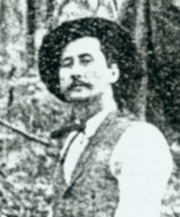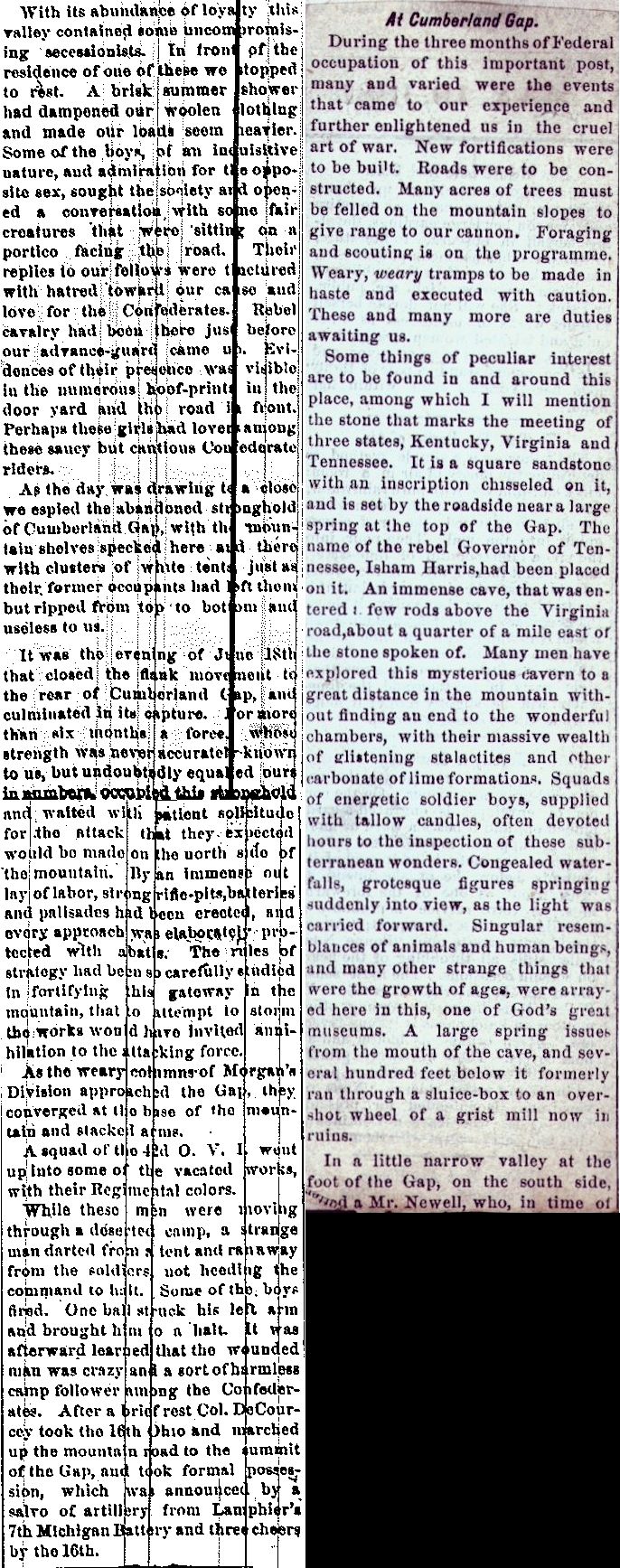| Camp & Field Page 20B | Camp & Field Index Page | 16th OVI Home Page | Camp & Field Page 21 |
The Camp & FieldArticles by Theodore Wolbach |
 Cpl. Theodore D. Wolbach |
The following image is taken from a book titled "Mortality and Statistics of the Census of 1850" in which it is believed retired Captain Rezin H. Vorhes, Company H, pasted over the pages a series of articles written by Cpl. Theodore D. Wolbach, Company E, titled "Camp and Field" and published, by chapter, in the Holmes County (Ohio) Republican newspaper from February 24, 1881 to August 17, 1882. The articles tell the story, in great detail and color, of the 16th OVI, from the inception of the 3-year regiment in October, 1861, through all its camps, battles and marches until it was disbanded on October 31, 1864. The articles pasted in the Vorhes book cover the first 35 chapters, published through October 20, 1881. All the remaining chapters were recently found in a Holmes County library by researcher Rob Garber who obtained copies, performed the transcriptions and provided to this website and which are also presented here, complete work by Theodore Wolbach.
Throughout these articles click on the underlined white text for additional details.
The webauthor thanks 16th Ohio descendant Rob Garber for his excellent research on the Camp And Field articles and for performing the tedious digital transcription of those articles found on each page. The transcriptions were made to reflect the original articles verbatim, misspellings and all. Rob is the 3rd great nephew of Capt. William Buchanan, Company F, 16th Ohio, who served in the 90-day regiment as a private, re-enlisting in the three year regiment, and eventually making the rank of Captain of Company F. Thanks Rob!
Note: Chapter 12
of the Wolbach articles was not included in the original Vorhes clippings. Obtained from the Holmes County library, it has been inserted here for continuity of reading.
Page 20C - Chapter 12, 13 - June, 1862
 |
With its abundance of loyalty, this valley contained some uncompromising secessionists. In front of the residence of one of these we stopped to rest. A brisk summer shower had dampened out woolen clothing and made our loads seem heavier. Some of the boys, of an inquisitive nature, and admiration for the opposite sex, sought the society and opened a conversation with some fair creatures that were sitting on a portico facing the road. Their replies to our fellows were tinctured with hatred toward our cause and love for the Confederates. Rebel cavalry had been there just before our advance guard came up. Evidences of their presence was visible in the numerous hoof-prints in the door yard and the road in front. Perhaps these girls had lovers among these saucy but cautious Confederate riders. As the day was drawing to a close we espied the abandoned stronghold of Cumberland Gap, with the mountain shelves specked here and there with clusters of white tents just as their former occupants had left them but ripped from top to bottom and useless to us. It was the evening of June 18th that closed the flank movement to the rear of Cumberland Gap, and culminated in its capture. For more than six months a force, whose strength was never accurately known to us, but undoubtedly equaled ours in numbers, occupied this stronghold and waited with patient solicitude for the attack that they expected would be made on the north side of the mountain. By an immense outlay of labor, strong rifle pits, batteries and palisades had been erected, and every approach was elaborately protected with abates. The rules of strategy had been so carefully studied in fortifying this gateway in the mountain, that to attempt to storm the works would have invited annihilation to the attacking force. As the weary columns of Morgan's Division approached the Gap, they converged at the base of the mountain and stacked arms. A squad of the 42d O.V.I. went up into some of the vacated works, with their Regimental colors. While these men were moving through a deserted camp, a strange man darted from a tent and ran away from the soldiers, not heeding the command to halt. Some of the boys fired. One ball struck his left arm and brought him to a halt. It was afterward learned that the wounded man was crazy and a sort of harmless camp follower among the Confederates. After a brief rest Col. DeCourcey took the 16th Ohio and marched up the mountain road to the summit of the Gap, and took formal possession, which was announced by a salvo of artillery from Lamphier's 7th Michigan Battery and three cheers by the 16th. |
his vision, that Mrs. Brashear was a true and devoted friend. Published in Holmes County Republican [XIII]. At Cumberland Gap During the three months of Federal occupation of this important post, many and varied were the events that came to our experience and further enlightened us in the cruel art of war. New fortifications were to be built. Roads were to be constructed. Many acres of trees must be felled on the mountain slopes to give range to our cannon. Foraging and scouting is on the programme. Weary, weary tramps to be made in haste and executed with caution. These and many more are duties awaiting us. Some things of peculiar interest are to be found in and around this place, among which I will mention the stone that marks the meeting of three states, Kentucky, Virginia and Tennessee. It is a square sandstone with an inscription chisseled on it, and is set by the roadside near a large spring at the top of the Gap. The name of the rebel Governor of Tennessee, Isham Harris, had been placed on it. An immense cave, that was entered a few rods above the Virginia road, about a quarter of a mile east of the stone spoken of. Many men have explored this mysterious cavern to a great distance in the mountain without finding an end to the wonderful chambers, with their massive wealth of glistening stalactites and other carbonate of lime formations. Squads of energetic soldier boys, supplied with tallow candles, often devoted hours to the inspection of these subterranean wonders. Congealed waterfalls, grotesque figures springing suddenly into view, as the light was carried forward. Singular resemblances of animals and human beings, and many other strange things that were the growth of ages, were arrayed here in this, one of God's great museums. A large spring issues from the mouth of the cave, and several hundred feet below it formerly ran through a sluice-box to an overshot wheel of a grist mill now in ruins. In a little narrow valley at the foot of the Gap, on the south side, lived a Mr. Newell, who, in time of |
| Camp & Field Page 20B | Camp & Field Index Page | 16th OVI Home Page | Camp & Field Page 21 |